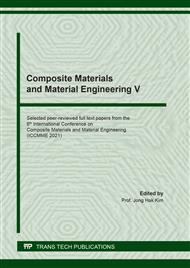p.65
p.73
p.79
p.85
p.91
p.98
p.107
p.112
p.123
Facile Fabrication of N-Slow Release Fertilizer Hydrogel Beads by Alginate-Based Composites
Abstract:
A novel slow-release N-fertilizer hydrogel beads were developed using sodium alginate (SA) and alginate-talcum (ST) composite as N-absorbent. In this work, the hydrogel composite were fabricated by simple method and low cost. N-fertilizer hydrogel beads were prepared two types, for SA types, which were different sodium alginate (1(SA1), 3(SA3), 5(SA5), 7(SA7), and 10(SA10) wt%). And, for ST types, sodium alginate and talcum were vary ratios to 1:0.5(S1T0.5), 1:1(S1T1), and 1:2 (S1T2). The chemical structure of hydrogel composite beads were characterized via Fourier transform infrared spectroscopy (FT-IR) and X-ray diffraction (XRD). The release behavior were investigate by Zero-order kinetic model, First-order kinetic model, Higuchi model and Korsmeyer-Peppas model. We have found that the N-fertilizer release constants in Korsmeyer-Peppas model were decrease with increase SA content for 1-5 wt% in SA hydrogel beads. However, SA contents were more than 5 wt% which rapidly enhanced fertilizer release. In addition, to add talcum in ST hydrogel beads significantly reduced fertilizer release rate. The N-fertilizer hydrogel beads exhibits significantly slow release behavior. These results indicates that the development of slow-release fertilizer hydrogel beads can be improve the effectiveness of N-fertilizer.
Info:
Periodical:
Pages:
91-97
Citation:
Online since:
June 2021
Authors:
Keywords:
Price:
Сopyright:
© 2021 Trans Tech Publications Ltd. All Rights Reserved
Share:
Citation:


